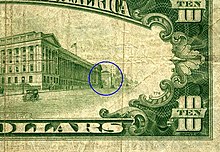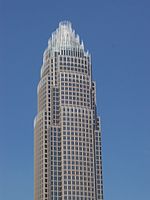American Security and Trust Company Building
American Security and Trust Company | |
 American Security and Trust Company Building in 2005 | |
| Location | 1501 Pennsylvania Avenue, NW, Washington, D.C. |
|---|---|
| Coordinates | 38°53′56.5″N 77°2′2.1″W / 38.899028°N 77.033917°W |
| Area | 6,989 square feet (649 m2) |
| Built | 1904–1905 |
| Architect | York and Sawyer |
| Architectural style | Neoclassical |
| NRHP reference No. | 73002070 |
| Significant dates | |
| Added to NRHP | July 16, 1973[1] |
| Designated DCIHS | November 8, 1964 |
The American Security and Trust Company Building is a Neoclassical bank office in Washington, D.C., designed by the architectural firm of York and Sawyer. It was listed on the National Register of Historic Places in 1973.[1]
Design
The building's neoclassical exterior closely matches that of the Riggs National Bank building next door, also designed by York and Sawyer and completed in 1902, so they are sometimes considered a single building.[2] The east facade of the building presents a multiple bay arrangement with two plain bays flanking a hexastyle portico of six Ionic columns and entablature, while the narrower and plainer south face has a single bay with two plain Doric pilasters flanking the entrance in a shallow recess.[1] The parapet conceals three skylights. Although the exterior has two rows of windows, the interior is a single floor, also decorated in the neoclassical style; it was remodeled in 1931–1932 but retained essentially the same form except for the removal of a pair of balconies and new openings into the adjoining annex which was constructed at the same time to the north.[1] A basement floor formerly contained vaults, but with the construction of the annex, these were moved to the adjoining building. The building exterior is constructed of granite ashlars with deep horizontal joints at the corners, creating a striped effect; the interior is largely faced in various marbles.[1]
History

American Security Bank was founded in 1889 in Alexandria, Virginia, as a banking and trust concern, operating a branch in the District of Columbia at 1419 G Street, NW; the following year it reincorporated in the District and moved to 1405 G Street.[1] Its president was Charles James Bell (Dublin, April 12, 1858 – October 1, 1929), nephew of Alexander Graham Bell.[3] It was the second trust company established in the District and the first to offer a women's department.[1] By 1903, the business had grown so that a new location was sought again.[1] The present location (a block from Lafayette Square and part of the Lafayette Square Historic District) was selected, and construction began in 1904. The design was praised in the banking press and featured in The American Architect and Building News in 1905.[1]
The building now houses a branch of Bank of America as a result of the latter's merger with NationsBank, which purchased MNC Financial in 1993.[4] MNC had purchased American Security Bank in 1987 but continued to operate it under the original name.[5]
Due to its location immediately north of the Treasury Building, the building appeared on the back of the ten dollar bill for many years,[6] a fact American Security took advantage of in its advertising with the slogan, "Right on the money".[7]
See also
References
- ^ a b c d e f g h i Brown, T. Robins (March 1973). "American Security and Trust Company". National Register of Historic Places—Nomination Form. National Park Service. Retrieved January 19, 2010.
- ^ Brown, T. Robins (March 2, 1973). "Riggs National Bank". National Register of Historic Places—Nomination Form. National Park Service. Retrieved January 22, 2010.
- ^ Death List of a Day: David Charles Bell, The New York Times, October 29, 1902.
- ^ Conn, David (August 3, 1993). "Fed approves MNC sale to NationsBank". The Baltimore Sun. Retrieved January 22, 2010.
- ^ Hetrick, Ross (November 28, 1990). "MNC wants to consolidate operations of two banks". The Baltimore Sun. Retrieved January 22, 2010.
- ^ Fodor's Washington DC. Random House. 1991. p. 76.
American Security Bank likes to boast in its commercials that it's "Right on the money"—"the money" in this case being a $10 dollar bill. If you look on the back of one you'll see the Treasury Building and to its right the tiny American Security bank building.
- ^ "Trademark search details for "Right on the money"". Boliven. Archived from the original on 2011-07-08. Retrieved January 22, 2010.


